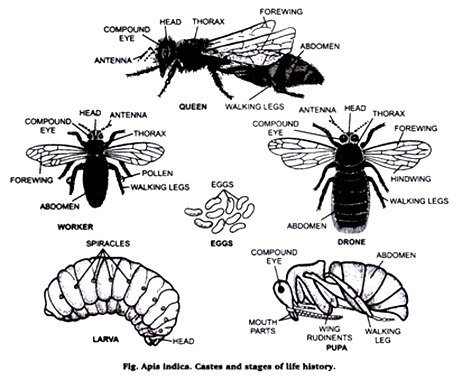In this article we will discuss about the life history of honey bee.
Classification:
Phylum: Arthropoda jointed appendage,
Class: Insecta 3 pairs of legs
ADVERTISEMENTS:
Order: Hymenoptera Membranous wings
Family: Apidae
Type: Apis indica
Habit and habitat:
ADVERTISEMENTS:
Commonly inhabits forests, plains and protected places like mud walls, earthen pots, thick lushes, wells and walls of buildings. The honey hives are made under branches of trees and any protected place in houses.
Distribution:
Cosmopolitan especially found in India, Canada, Australia and New Zealand.
Comments:
ADVERTISEMENTS:
1. Commonly called as Honey bee.
2. Life-cycle stages comprises egg, larva, pupa and adult. Adults are of 3 types namely queen, worker and drone.
3. Queen is 15-20 mm in length and consists of antennae, compound eyes, head, thorax long tapering abdomen, short legs and wings. It feeds on Royal Jelly and lays 1500 and 21000 eggs in a day.
4. Workers have long proboscis for sucking nectar, strong wings, pollen-basket, sting and wax gland.
5. Drone is a male called as king which is without pollen collecting apparatus and wax gland. Function of Drone is to fertilize queen. Drone measures 15-17 mm in length.
Economic importance:
Honey bee as economically very important insect. Bee keeping has developed into Apiculture industry in various countries. Honey bee produces honey and wax. Honey is used as food and also as medicinal product. Honey contains levulose, dextrose, maltose, ash and water.
As medicinal substance it is laxative, antiseptic and sedative. Waxes have several important use in manufacture of candles, Wax is used as embedding substance for microtomic sections and in all biopsy and histopathological studies.
